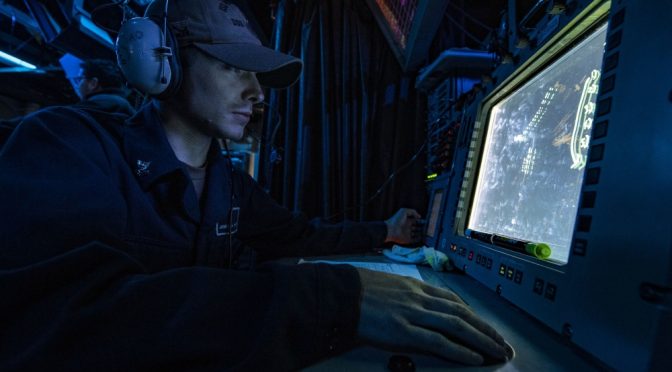Notes to the New CNO Topic Week
By LT Douglas Kettler, USN
Every Marine a rifleman. This mantra resonates with the nation and highlights a fundamental fact about the USMC – no matter what a Marine’s primary job is, they are expected to be able to pick up a weapon and fight.
The CNO, having been a previous commander of U.S. Tenth Fleet/Fleet Cyber Command, should instill this same principle into his Sailors with a new creed, “Every Sailor a cyber warrior.” Given that the CNO is taking charge of numerous complex naval weapons systems that nearly all depend on the cyber domain to ensure their lethality, it is extremely vital that the CNO foster cyber literacy, programming skills, and robust cyber hygiene across the force. Similar to learning a new language, this process may appear difficult, but as a 2015 RAND study suggests, the impact could save the Navy billions of dollars and prevent critical network infiltrations.
This change will benefit the Navy in two primary ways, innovation and cyber defense.
First, naval innovation will be unleashed through advancing Sailor-driven programming skills and Sailor-driven coding solutions to improve computer-based weapons systems. The USAF has embraced airmen-driven innovation schemes with programs like the “Kessel Run,” while the Navy has continued to be beholden to expensive and slow contractor “solutions” to Sailor needs.
An emphasis on cyber will squeeze the most effectiveness and innovation out of fielded weapons systems by having the Sailors that run the systems manage an improvement cycle at little to no cost. A recent success story along these lines is seen in the Maritime Patrol community with a junior officer who drove innovation from the front while the contractors struggled to catch up. The CNO’s approval and fostering of similar types of programs across his weapons platforms at the Fleet level could unleash a wave of combat lethality and innovation unrealized since Eugene Fluckey created land-attack strike and special operations missions for the submarine force in World War II.
Second, cyber defense is critical to maintain if Sailors are trained and encouraged to make programming improvements for weapons platform software. This is where the CNO can generate outsized returns for his Navy. The current system of Cyber Awareness General Military Training alone does not cut it. The CNO must go further and inculcate more impactful and more frequent cyber training. This means cyber training that focuses on how the cyber domain specifically impacts the Sailor’s rating and the Sailor’s weapon system, not just their cellphone. While extremely important, social network operations security, personal electronics management, and other traditional “all-hands” cyber efforts are entry-level education that all Sailors are expected to understand. The next level of fleet-wide cyber education should show the Sailor how the domain impacts their lethality and arms them with the education to recognize, respond, and overcome adverse cyber effects.
Through the new creed of “every Sailor a cyber warrior,” the CNO will be able to leverage his experience at Tenth Fleet to arm the Navy with the foundational skills necessary to fight and prevail in twenty-first century network-centric warfare.
Lt. Douglas Kettler is a P-8A Naval Flight Officer and Weapons and Tactics Instructor in the U.S. Navy. He is an associate editor with CIMSEC. His views are his own and do not reflect the official position or policy of the U.S. Government, the U.S. Department of Defense, or the U.S. Navy.
Featured Image: PACIFIC OCEAN (July 25, 2019) Operations Specialist 2nd Class James Martin, from Pennridge, Pa., plots surface contacts in the combat information center (CIC) aboard the Arleigh Burke-class guided-missile destroyer USS Paul Hamilton (DDG 60). (U.S. Navy photo by Mass Communication Specialist 1st Class Julio Rivera/Released)


Is “cyber” the next fad for the services to push, trying to get “more” of something they don’t understand how to quantify?
Cyber literacy, cyber hygiene, and awareness of the cyber aspects of a sailor’s warfare area are important, but returns diminish rapidly for teaching advanced skills to sailors outside the cyber field, so we cannot afford to let this fad crowd out other more vital skills. There is a long list of traditional warfighting skills that the US Navy has demonstrated deficiencies in which will kill us faster than any cyber vulnerability.
With regard to all those Sailor-driven innovation schemes you seem to be counting on to supersede “expensive and slow contractor ‘solutions’,” you clearly aren’t at the level where you get to spend the Navy’s money. Sailors are faster because their time is “free” (not really, but already paid for) and nobody needs to approve a contract, or worse, get funding appropriated through Congress. Definitely take any “free” solution your Sailors can come up with, but you will still hit problems far beyond the technical capabilities of young and narrowly-experienced minds to fix, and you may waste of lot of time and parts if you try too long.